35 Short Nonfiction Books for Reluctant, Struggling, & Wiggly Readers
This post may contain affiliate links.
Struggling readers, reluctant readers, and wiggly readers all benefit from reading short nonfiction books or even longer, browseable nonfiction books where readers can jump around in their reading sequence. Actually, all children need to be reading nonfiction, and these shorter books are a great place to start!
Browseable nonfiction books are books that kids can flip through and read whatever strikes their fancy in any order. Fun, right? Read more about the 5 types of nonfiction.
Some growing readers like shorter bursts of reading with frequent breaks. Browseable nonfiction is perfect for this because they won’t lose comprehension like they would in fiction.
Because reading nonfiction is a different kind of comprehension experience for the reader. That’s why it’s essential we give kids plenty of nonfiction reading practice in high-quality and high-interest books.

Whenever I assessed my elementary students’ comprehension, 90% of the time, their fiction comprehension was an entire year or two higher than their nonfiction comprehension. Yes — that’s significant! This is because most kids read more fiction than nonfiction and therefore have better comprehension skills in fiction. Practice makes progress so let’s add in more nonfiction!
Give these short nonfiction books a try with your students and children. You’re going to learn a lot, and so will they. Have fun!
Tips for Nonfiction Book Selection
Get books with great photographs.
Seriously. If the book has photographs, it’s much more engaging to readers. Plus, a book with borders, different colors, and colorful backgrounds appeal to young readers.
Watch text to picture ratio.
If there is a ton of text crammed into a page, it’s not appealing to read. Look for books with not too many words all crammed together. Look for text boxes and blank spaces on the page. That’s less intimidating and way more exciting to read.
Pick something your child is interested in.
I only read nonfiction books about topics in which I’m interested. I just cannot motivate myself to read the history tomes my husband enjoys. Same for your kids, right? Go with their interests!
Teach text features of nonfiction.
It’s often helpful to teach kids about the text features of nonfiction books. Unlike fiction novels, nonfiction books don’t have to be read cover to cover. Teach kids about:
– Table of Contents
– Glossary
– Index
– Titles and headings
– Bold words
– Captions
– Charts and diagrams
Start with that, and let me know how it goes!
Short Nonfiction Books for Ages 7 to 12

Explore the Beach: Little Kids First Nature Guide by Alli Brydon
OCEAN
Not only does this nonfiction book contain appealing, colorful photos and facts about the ocean, but it also introduces readers to the text features of a nonfiction book. With headers and captions, sidebars and bolded words, this book does double duty; it teaches kids about nonfiction text while sharing cool information about the plants and animals in and around the beach. LOVE IT!

Where the Weird Things Are: An Ocean Twilight Zone Adventure by Zoleka Filander, illustrated by Patricia Hooning
OCEAN
A personified underwater explorer robot named Meso narrates his adventure deep in the ocean. He speaks to the creatures he meets, and they tell him about themselves. Filled with lots of banter and dialogue, the result is enjoyable and playful while being informational.

Search for a Giant Squid: Pick Your Path by Amy Seto Forrester & Andy Chou Musser
CHOOSE YOUR OWN ADVENTURE / OCEAN ANIMALS
I love this choose your own adventure format and so will kids. Join an expedition on a dive to the deepest ocean depths to search for a giant squid. Choose which pilot to be, the submersible you’ll use, and the dive site, and then start your adventure. What will you discover? What will you do with mechanical problems or bad weather?

Good for the Future: Sustainable Farms Around the World by Mia Wenjen, illustrated by Robert Sae-Heng
FOOD
Written in rhyme, learn about how different places around the world have created sustainable farms — and why it’s important. A rooftop garden grows food in the USA. Tree-shaped gardens collect rainwater and make solar power in Singapore. Underwater, greenhouse pods grow gardens in Italy. Back matter explains more about sustainable farming, food justice, a map of the places in the book, and gives information about each sustainable farm practice.

The World’s Best Jokes for Kids Volume 1 by Lisa Swerling & Ralph Lazar
JOKES
Each of these jokes is illustrated with I really love because it gives struggling or new readers extra picture support for decoding and comprehension. This series (volume 2 is here) shares jokes that will make your kids laugh, groan, and share with all their friends. Jokes like:
Why are pirates called pirates?
Because they arrrrrrr.
Why was the dog feeling sorry for himself?
Because his life was so ruff.
HAHAHA!
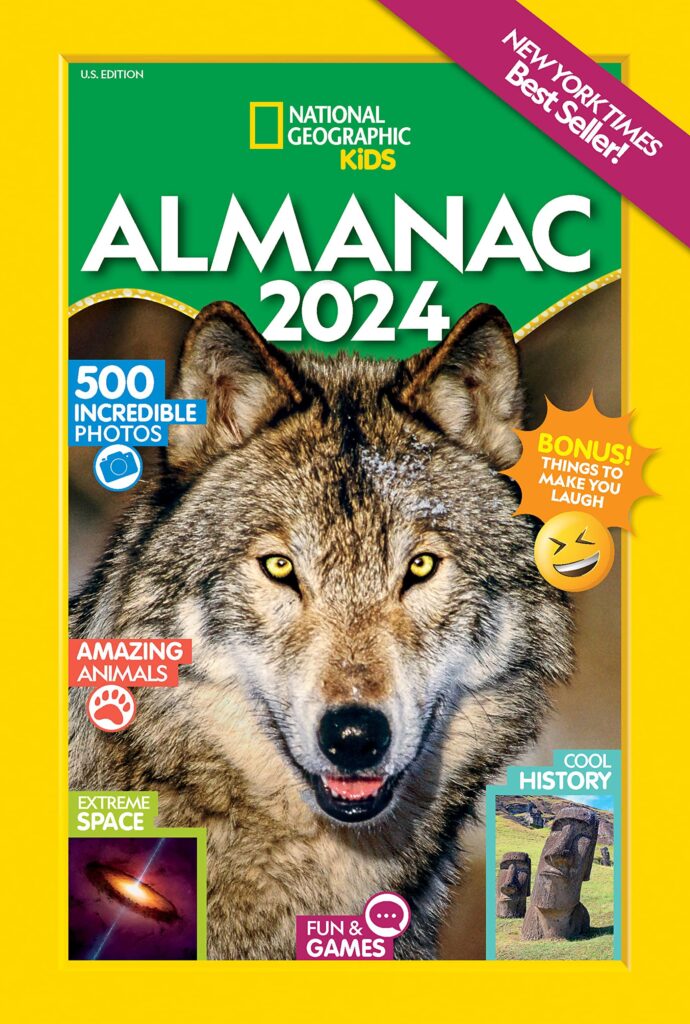
Almanac 2024 National Geographic Kids
STEM
The National Geographic Almanac is a must-own resource for families and growing readers. Practice your nonfiction reading comprehension skills as you learn about animals, space, science, history, geography, etc. Each page is designed to entertain and educate with stunning layouts and eye-popping photographs.
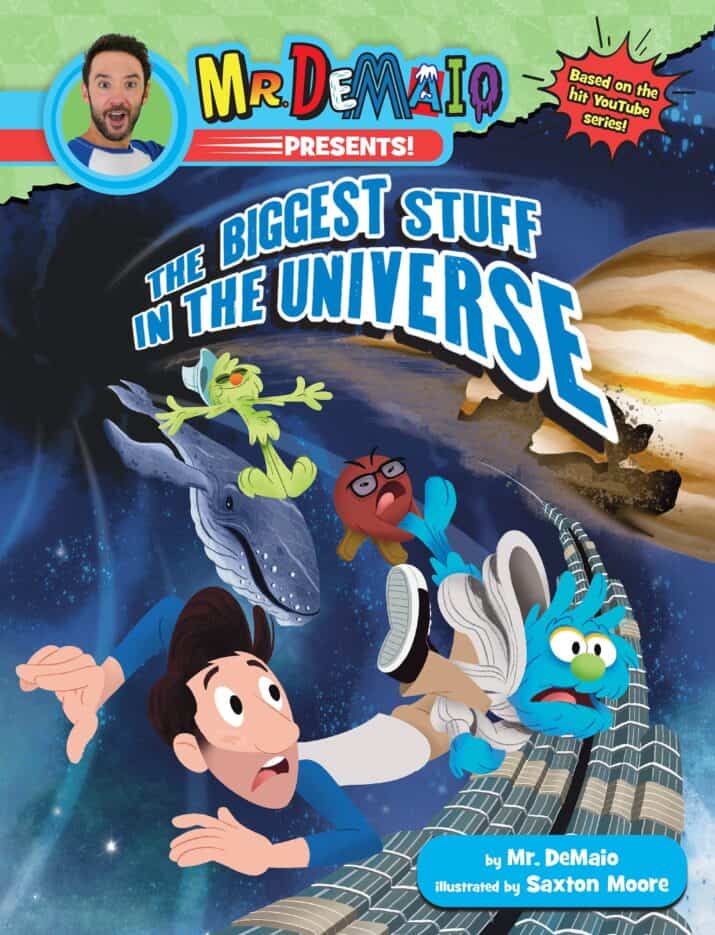
The Biggest Stuff in the Universe by Mr. DeMaio, illustrated by Saxton Moore
SCIENCE
Get ready to learn cool facts about BIG things — with photographs, cartoons, and illustrations! From the largest tree to the largest exoplanet to the biggest thing in the known universe (the Hercules Corona Borealis Great Wall), Mr. DeMaio make learning about science on earth and in space FUN!

Personality Quizzes by Tracey West
QUIZZES
If your kids are like mine, they love taking personality tests online. Now there’s a better option…quizzes in this book from National Geographic Kids! Which mythical creature are you? Which gemstone are you? Are you a dog or a cat? Who would be your robot sidekick? Each quiz is fun and exciting, plus you’ll get the amazing graphic design and photography you can always expect from NatGeo. Now, I’m off to find out if I would make a good pirate…

Totally Wacky Facts About History by Cari Meister
HISTORY
This reminds me of the Strange But True books only about history and from a different publisher. And I LOVE IT! This little book makes history interesting to kids — it’s filled with colorful photos and illustrations and yes, wacky facts. Here are a few to get you started:
Early Chinese spies flew on large kites to gather information about their enemies.
Ancient Romans were the first to record seeing UFOs.
Napoleon suffered from ailurophobia. That means he was afraid of cats.
Crazy cool, right? It makes you want to know more!

Weird But True!
FACTS
Kids universally love these weird and random facts, but that’s not the only awesome thing about Weird But True books…The book is so interesting and feels like a completely different reading experience. Why? Because there are lots of colorful photographs plus just a one-sentence fact. It’s perfect to entice even the most reluctant of readers don’t you think? And you can pick it up in the middle and don’t have to remember what happened earlier. (Browseable.)

Weird but True SPORTS: 300 Wacky Facts About Awesome Athletics
SPORTS
The facts weird, go figure, and come from a wide range of topics and sports. (Did you know professional hockey players can be penalized for tucking their jerseys into their pants?!) Learn crazy facts about skateboarding, ostrich races, and jet sprint boats! Highly recommended.
ALSO READ:

The Minecraft Essential Handbook: An Official Mojang Book by Scholastic
MINECRAFT
Learn how to find resources, make a shelter, craft tools, protect yourself from monsters, and more basics in this guide to surviving Minecraft. My daughter loves this series of books.

You Can Be a Paleontologist! National Geographic Kids by Scott D. Sampson, Ph.D.
DINOSAURS
Each section of information begins with a question like “How do you find fossils” and then answers the question using text, photographs, and informational inserts. Dinosaur fans will be excited to learn just how scientists find, store, study, and figure out more about the dinosaurs they study — all from the bones. Ultimately, clear information with enticing photographs makes this an excellent choice for dinosaur and science enthusiasts.

Weird but True! Greek Mythology by Sarah Wassner Flynn, illustrated by Chip Wass
GREEK MYTHOLOGY
From National Geographic Kids, this book is dense, colorful, and info-packed. It’s almost too busy for my tastes, but I’m old –many kids like this style. I like the writing a lot — it’s kid-appropriate while sticking to the basics of each myth. Because I know that much of the Greek myths aren’t always g or pg (think violence and sex), so I really appreciate the lack of TMI in this book!

The Power of Architecture: 25 Modern Buildings from around the World by Annette Roeder, illustrated by Pamela Baron
ARCHITECTURE
I shared this book at the dinner table with my family because the buildings are so cool. It’s well-written and cleanly illustrated; any child would want to read this whether or not they have an interest in architecture or not.

So You Want to Be a Ninja? by Bruno Vincent, illustrated by Takayo Akiyama
Engaging and entertaining, full of facts, trivia, quizzes, and fun, this is the essential illustrated guide for ninjas-in-training. Three friends travel back in time to 1789 Japan where they’re taught by famous ninjas.

The World’s Strangest Predators Top 40 Weird and Wonderful Carnivorous Critters
ANIMALS
Do you know the strangest predators? You might be surprised to learn that #40 on the list is the short-tailed shrew — a tiny terror with venom glands who is a predator to frogs and mice. Learn more about weird predators in this unique book that includes the Tasmanian devil, tentacled snake (so gross), pirate spider, and #1 — the honey badger! And to think I thought honey badgers only ate honey. (Silly me!)

Barefoot Books Amazing Places by Miralda Colombo, Beatrice Cerocchi
GEOGRAPHY
Discover 15 impressive places in the world. Each place gets four pages. The first two-page spread introduces the landmark. The next 2-page spread gives you facts and information about the landmark. If your kids want to learn more about the world, they’ll love this resource.

100 Things to Be When You Grow Up by National Geographic
CAREERS
Some kids change their mind every few weeks about what job they want to do when they grow up — but imagine what they would do if they only knew ALL the possible jobs! This book shares the details about 100 really cool jobs along with gorgeous photographs (of course). And it’s all presented in a very kid-friendly way. (Of course.) I’m giving this book to both my kids because I think they’ll be excited to learn about these unusual jobs: pet food taster, perfumer, crossword puzzle writer, ice sculptor, and movie trailer editor. Wouldn’t your kids?

Dino-Mite (Science with Stuff ) by Sarah Parvis
DINOSAURS
Will the fossilized dino poop entice you to read this book? It just might help you turn the pages to learn more about dinosaurs. The book is well-organized and informative with full-color, glossy pages, and kid-friendly layouts, making it a good choice for elementary school dinosaur fans.

Animal BFFs by Sophie Corrigan
ANIMALS
I love the funny dialogue bubbles of conversation between animal “friends” that you haven’t ever heard about — like warthogs and banded mongooses or ruby-throated hummingbirds and spiders– and why they’re paired up. Delightful, interesting, and informative.
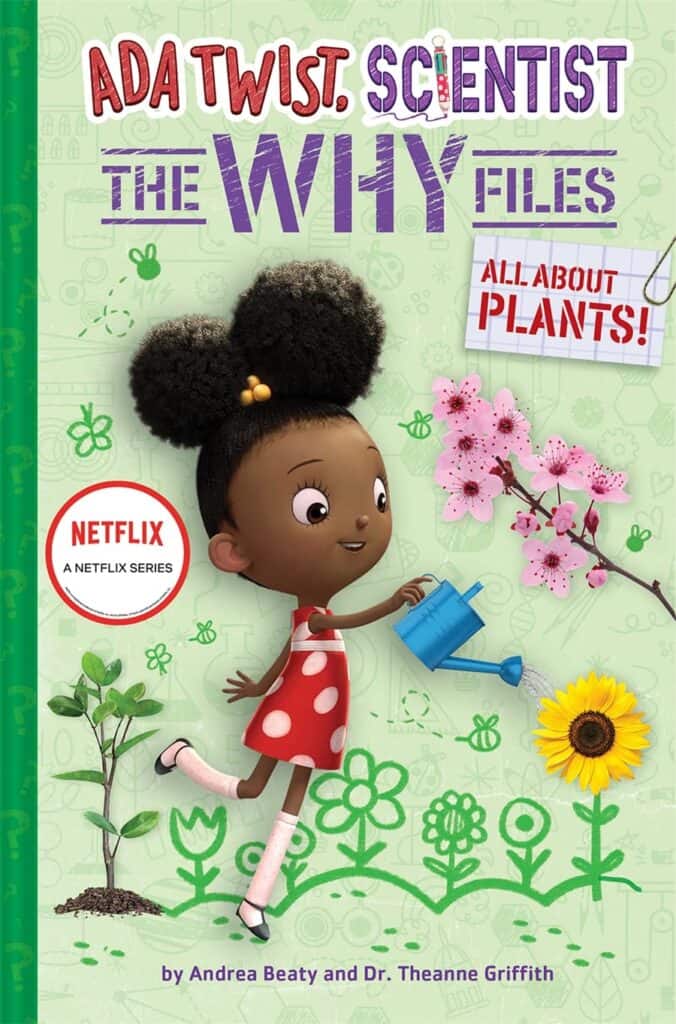
All About Plants: Ada Twist, Scientist The Why Files by Andrea Beaty and Dr. Theanne Griffith
SCIENCE (series)
Packed with information, this nonfiction Ada Twist book about plants hits the right spot for primary ages 6o to 9. Full-color photographs, diagrams, labels, cartoons, and informational text answer big questions like “How do they eat?” and “Do plants need air like me?“ I like this book — the writing and format are excellent. But I do wish these books included a table of contents and glossary.

Celebrating Groundhog Day by Karen Bush Gibson
HOLIDAY
Karen Bush Gibson’s writing won’t just teach readers about Groundhog Day, but they’ll also become an expert on the related history, celebrations, and geography. Captivating and packed with information, this nonfiction gem is perfect for elementary readers.

A Brief History of Underpants by Christine Van Zandt, illustrated by Harry Briggs
HISTORY
It’s true– even people in ancient times wore underwear! Whether it was an Inuit in caribou skin underwear or Egyptian loincloths or quilted, padded underpants of European knights, kids will read all about the history of underwear, inventions like the sewing machine that changed the world of underwear, and plenty of fun facts about underpants! Well-written with punny humor, facts, and comic illustrations, this little nonfiction book for young readers is a delight! (Here’s a joke from the back of the book… Q: Why does a pirate wear underpants? A: To hide his booty.)

What if You Could Spy Like a Narwhal?! by Sandra Markle, illustrated by Howard McWilliams
ANIMALS (series)
Narwhals use echolocation to find food and survive. If you had echolocation, you might discover a sunken treasure or find the shortest way out of a maze. Learn fascinating facts and unique characteristics (superpowers) about interesting animals a narwhal, lyrebird, giant cuttlefish, three-banded armadillo, or a colugo.

The Mayflower (History Smashers) by Kate Messner, illustrated by Dylan Meconis
HISTORY (series)
Kids would love history if all history books were this engaging and well-written. Fascinating facts share about the not-always-balanced perspective of primary sources and the usefulness of archeology. The author debunks myths like Plymouth Rock and the First Thanksgiving, explaining ow the plague that decimated the Wampanoag people prior to the Pilgrim’s arrival. It’s clearly well researched with a broad perspective. It’s accessible and easy-to-read with cartoons, illustrations, diagrams, and informational inserts.
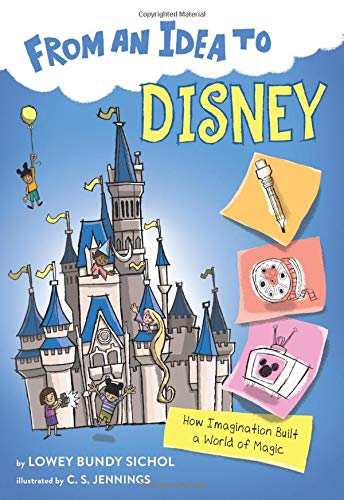
From an Idea to Disney How Imagination Built a World of Magic by Lowey Bundy Sichol, illustrated by C.S. Jennings
I’ve read many other biographies about Walt Disney, but this one stands out for its writing, pertinent information, and appeal. It shares about the business that continued on even after Walt’s death and his brother’s death including the merger with Pixar and the successful but controversial CEO, Michael Eisner. Fascinating!

The Superpower Field Guide Eels by Rachel Poliquin, illustrated by Nicholas John Frith
EELS (series)
Filled with fascinating facts written in a conversational voice, this eel book in the series brims with pizazz! Follow the story of Olenka, an amazing eel of secrets and superpowers. Full-color illustrations, humor, facts, so many facts, you won’t be able to put this book down.

Everything Awesome About Sharks and Other Underwater Creatures! by Mike Lowery
SHARKS (series)
The Everything Awesome book series continues with SHARKS! Handwriting and kid-like fonts ,plus lots of comic illustrations and colors, make this a visual feast for the eyes. But it’s filled with a wealth of facts about the ocean, underwater creatures, and of course, sharks. From information about ocean zones to prehistoric sharks and kelp forests, this book covers ocean information in a fun, often hilarious, way.

Copycat Science by Mike Barfield
BIOGRAPHY / SCIENCE EXPERIMENTS
Part biographies and part experiments, this nonfiction book narrated in cartoon format makes science fun! Learn about each scientist in their short biography, then apply and learn more about their area of study by doing the related experiment. Read about James Audubon then make a bird feeder. Then read about Rosalind Franklin and do an experiment about a strawberry’s DNA. Topics include living things, human biology, materials, air, electricity and magnetism, forces and physics, astronomy, math, and more.

How Do Meerkats Order Pizza? by Brooke Barker
BIOGRAPHIES / ANIMALS
You might think this book is about meerkats. It’s not. It’s an engaging and informative book about different scientists who specialize in specific areas of study — including meerkats. The book is illustrated in comics with dialogue bubbles and handwritten text. It’s amazingly dense with factual information but remains easy to read, interesting, and appealing to the eye.

GUM How it Happened The Cool Stories and Facts Behind Every Chew by Page Towler, illustrated by Dan Sipple
HISTORY
Did you know that gum has been around since the Neolithic era? Learn about the history of gum, the types of gum from different cultures, more recent gum iterations, and modern gum. The authors will hook readers with the writing and design, but readers will stay for the information. It’s fascinating!

Save the Lions by Sarah L. Thomson
ENDANGERED ANIMALS
Well-written and interesting, kids will enjoy this middle-grade book all about lions. Readers will learn about where they live, lion life, why lions are endangered, and who has been saving lions. Like all nonfiction books, you’ll find common nonfiction text features, including captions, black and white photos, bolded vocabulary words, and headers.

Baby Animals (Animal Planet) by Dorothea DePrisco
ANIMALS
Gorgeous photos and interesting facts make this one of those books you can easily flip through to find the photos and interesting facts about young animals you want to read. Plus, the cuteness factor is off the charts.
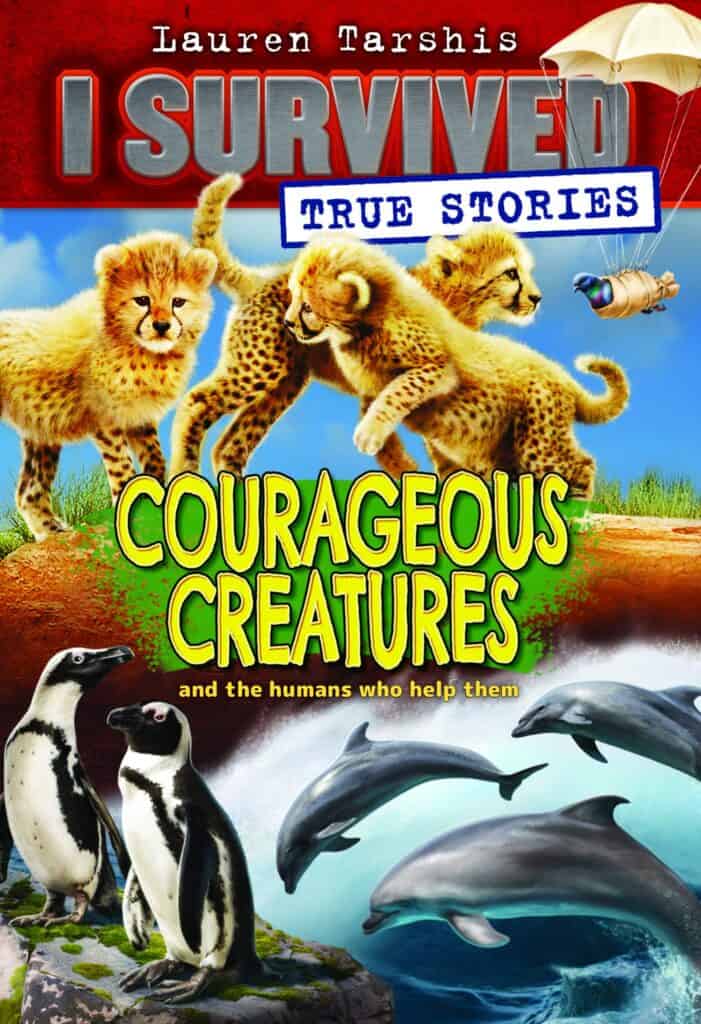
Courageous Creatures and the Humans Who Help Them I Survived True Stories by Lauren Tarshis
ANIMALS
Superb! Four compelling stories of animals and humans will keep readers engaged. From carrier pigeon hero of WW I to cheetah cubs adopted by a human, these will share true stories for any animal lover. Filled with lots of black-and-white photographs and factual information that supports each story. For example, read about echolocation related to the dolphin story and general information about marine animals. Highly recommended.

KEEP READING










Is there a way to get a printable version of the list of books that you suggested? I would like to make sure I have them in my library for teacher and student access and a printable list would be so helpful. Thank you so much.
yes — I’ll try to get to it later today.
Here you go — https://imaginationsoup.net/wp-content/uploads/2019/03/Short-Nonfiction-Books.pdf